| Product(s): |
SewerGEMS |
| Version(s): |
V8i, SELECTseries 5 -08.11.05.58 |
Overview :
The SELECTSeries 5 release of SewerGEMS includes many new features and improvements. This technote explores these new changes.
- Support for Newer Platforms and Operating Systems
- Integration with Bentley OpenRoads
- Support for opening .DGN files
- Taps and laterals
- Assign Taps to Links tool
- Tap Locations in Profile View
- SWMM 5.1 support including seepage
- Ribbon in AutoCAD mode
- Improvements to GVF Convex logical controls window.
- Show terrain model in profile view
- Elevated pipes in profile
- Design solver improvements
- consider cover over length of conduit (using terrain model)
- On-grade spread check
- Visual changes to Flex Tables
- Improvements to the GVF Convex Solver Memory Management
- Batch morph
- GVF convex solver memory management improvements for large eps models
- Improvements to HEC-22 3rd Edition Calculations
- Brentwood industries storage chamber library
- H2S calc improvements
- Rational method frequency factor
- GIS Style Symbology in MicroStation
- MicroDrainage Import/Export
- Merged/integrated StormCAD for UK
- Bentley Map Data source in ModelBuilder
- Communities search
- RSS feeds in standalone
Support for Newer Platforms and Operating Systems:
The following platforms & operating systems are supported:
- Windows 7, SP1 (32 bit/64bit)
- Windows Vista SP2 (32 bit/64bit)
- Windows 8, 8.1 (32/64 bit)
- AutoCAD 2014, 2015, 2016 (32 bit/64 bit)
- MicroStation V8i SELECTseries 3
- ArcGIS 10.2 or 10.2.1, 10.2.2, 10.3*
- ProjectWise V8 XM Edition or later
Note : To integrate ArcGIS 10.3 with SewerGEMS you need to install patch from ESRI.
Please have a look at this support solution, which explains it.
Integration with Bentley OpenRoads
SewerGEMS design and analysis functionality has been added to the Subsurface Utility Design and Analysis (SUDA) technology which is a part of OpenRoads products (starting with the SELECTseries 4 release). This can be thought of as another platform, “SewerGEMS for OpenRoads”, but with tighter integration.
Functionality highlights include:
- 3D physical modeling of storm/sewer networks along with the design and analysis functionality of SewerGEMS.
- 3D models can be driven by hydraulic design constraints such as minimum and maximum slopes, velocity, cover and pipe sizes. Change are reflected in the 3D model.
- Hydraulic elements can be laid out by taking reference of elevations of other utilities like road, drainage etc.
- Available Hydraulics and Hydrology (SewerGEMS) functionality includes:
- Scenarios, alternatives, hydraulic designs, numerical solvers, graphs, profiles
- Tools like: PondMaker (constraint based pond design), ModelBuilder (importing external data), Terrain Extractor (populate ground elevations automatically)
- Globally respected hydraulic design methodologies meeting requirements of HEC-22 3rd edition, TR-55 and others.
- New Lateral element type (see details further below) for more accurate representation of lateral or service connections in a physical model in SUDA. Laterals connect directly to a pipe via a Tap connection.
- Import and create a hydraulic and 3D physical model from a variety of file types: the below formats (available options depend on active license)
- .stsw / .stsw.sqlite (existing StormCAD, SewerCAD, SewerGEMS of CivilStorm model)
- EPA SWMM
- Landxml
- Micro Drainage
- Bentley InRoads
- Spreadsheet, database, shapefile, DXF (using Modelbuilder)
- The standalone versions of StormCAD, CivilStorm, SewerCAD and SewerGEMS can access the hydraulic models inside of DGN files created by Subsurface Utility Design and Analysis.
- The addition of our Subsurface Utility Engineering product adds conflict resolution (clash detection) of buried utilities.
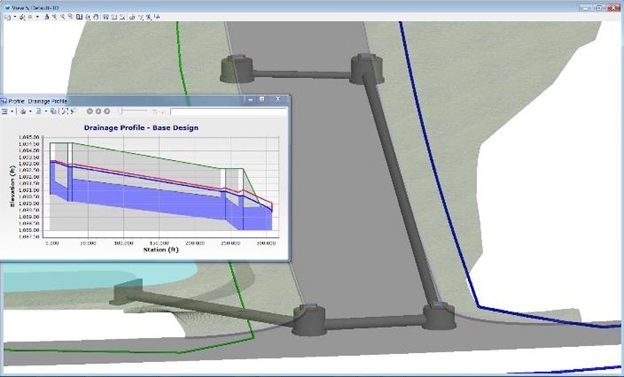
Support for opening a .DGN file
A .DGN file can be opened from the File menu. Go to File > Open and browse to where the DGN file is located. In the File Name dialog box type in * followed by hitting the enter key. This will reveal the .DGN file.
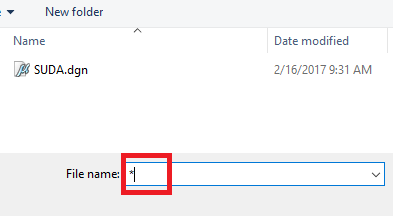
Taps & Laterals
Bentley SewerGEMS V8i SS5, now support taps and laterals elements. A Tap is a type of node that connects the lateral to the conduit. It enables the user to add inflows along a conduit or channel without the need to break the link element into multiple elements. There could be a number of lateral connections to a single trunk conduit.
Although it can be used with manholes in a sewer model, the primary use of the Tap and Lateral element are road and site design engineers and OpenRoads users (see above) because this level of detail is more significant when working with a physical model. For example an OpenRoads user (starting with the SS4 release as mentioned above) might need to use the Subsurface Utilities Engineering (SUE) clash detection tool, in which case the exact location of the lateral and tap is important. Since this is the primary intent of the tap and lateral feature, it is not recommended to use this in very large models, where Modelbuilder would be required to import a large number of taps and laterals. Future versions of SewerGEMS may introduce a sewer Customer element type where the added detail of the tap+lateral+manhole would not be necessary.
Note:
- They are not supported in the Dynamic Wave solver.
- With the SWMM solver, Laterals are treated as "dummy" conduits.
- The SewerCAD (GVF-Convex) solver does not do any hydraulic calculations in the lateral pipe.

Assign Taps to Links tool
This newly introduced tool is located in the Tools menu and allows you to automatically assign the tap nodes to the nearest link i.e. to the conduit. This is useful in cases where for example the taps and laterals were imported through Modelbuilder, where you may otherwise need to manually assign the associated conduit one by one.

Tap Locations in Profile View
With the release of SS5, you can see the tap locations in the profile view.
The location of tap in the profile view will change as you change the connection in the properties of taps (Invert to center or Invert to soffit) and as you move the tap along the length of the pipe.


SWMM 5.1 support including seepage
The SWMM solver supports a user-defined infiltration flow (Flow /Additional Infiltration) and other solvers have additional support to allow a few different load types, see "Conduit-Infiltration/Inflow and Seepage" for details.
Seepage is the flow loss from the system; it is the seepage of the conduit (or channel) from its bottom and side walls into conduit's surrounding soil. Only SWMM solver supports the conduit seepage loss calculation among the four solvers. you can specify a seepage loss rate and the solver calculates the seepage loss at each time step using the loss rate and conduit flow area (based on the length and wetted-perimeter).
Ribbon in AutoCAD mode
AutoCAD ribbon view of SewerGEMS tools has been modified now, by having all the tools at one place.

Improvements to GVF Convex logical controls window.
In the GVF-Convex solver, the user can use both logical controls and locally defined on/off controls on the pump's Properties editor. In cases of a conflict between the two types of control, the locally set on/off controls are ignored by the solver and a user notification is generated.
Alternatively, the user can set the Ignore On and off Elevation? , attribute in the Operational section of the pump properties grid to True.
User can see all controls and control sets on one dialogue.
Show terrain model in profile view
If you have set up any terrain model in the SewerGEMS model, then you will be able to view that terrain model in the profile view. Terrain model should be active to use this option.
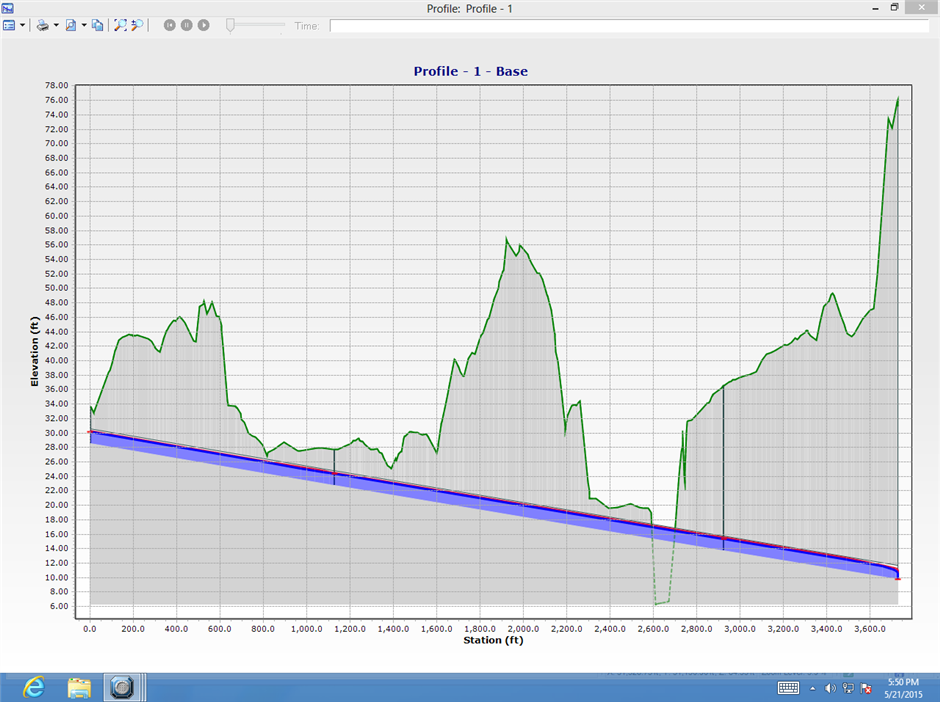
Elevated pipes in profile
The profile view of a pipe that is above the ground elevation has been improved.

Design solver improvements
a) Considering cover along pipe length
The ability to import and use Digital Terrain Models (DTM) has been significantly enhanced and includes the ability to account for cover along a link in profiles in constraint based design (GVF Rational or GVF Convex Solvers) if a DTM is activated. Consider cover over length of conduit (using terrain model). With this enabled, you can have cover along the length of pipe, using the elevations from the active Terrain model.

b) On grade spread check
With this version we have improved the solver’s ability to size On Grade inlet opening in the GVF-Rational Solver. Now inlet design constraints can be defined for both on-grade & in-sag inlets, which was previously available only for in-sag inlets.

Visual changes to Flextables
Flextable has been made more user friendly, allowing you select the whole column by right clicking on it, Check boxes are now shadowed. The text in boxes is spaced a little more and is much easier to read.
If you need to copy & paste the data from the flex table, you can do so by right clicking on the column heading>Select Column>Click on the copy button>go to where you want to copy the column and click on the paste button.

Improvements to the GVF Convex Solver Memory Management
Improvements have been made in how the GVF Convex Solver stores the data as it is computing the model. This will be especially notable in large models running in an EPS simulation with small time steps.
Batch Morph
Batch morph tool is available for SewerGEMS as well now, which was available before only for water products. Using this tool you can morph one element type into another of element. Like from manholes to catchbasins, transitions,headwalls etc.

GVF convex solver memory management improvements
GVF-Convex solver is modified in this version SS5 of SewerGEMS to handle the large models without causing the memory issues.
Improvements to HEC-22 3rd Edition Calculations
Improvements have been made to the GVF-Rational and GVF-Convex solvers regarding junction losses and near-plunging conditions.
Brentwood industries storage chamber library
New Storage chamber library of Brentwood industries storage has been added to storage chamber library.
H2S calculation improvements
Hydrogen sulfide calculations now include reactions in wet wells, improving the calculations of H2S.
Rational method frequency factor
Frequency factor has been added to the Rational Method. To aid in the pairing of larger storm events with the Rational Method or Modified Rational Method, one option is to utilize the calculation options available for employing Frequency Factors.
With the use of a Frequency Factor term the Rational Method effectively becomes:
Q=C'iA
Q = Rational Flow
C' = Runoff Coefficient (Adjusted)
i = Intensity
A = Drainage Area
C'=CfC
Cf = Frequency Factor corresponding to the storm's Return Period (T)
C = Runoff Coefficient (Unadjusted)
You can enable use of frequency option through calculation option.

GIS style Symbology in Microstation
GIS style Symbology (also known as zoom independent visibility) is now available to control drawing characteristics in element Symbology with the Microstation platform. Previously this was only available for Standalone version.
When using this, if you annotate any element with any field, you will be able to see that value even if you zoom in & out in the GIS style.
MicroDrainage Import/Export
In this release of SewerGEMS, you can import & export the Micro Drainage files directly. This is done from the File > Import > MicroDrainage and File > Export > Microdrainage menus. When imported, it will open up in a new project. The file types are are .sws, .ews, and .fws.

Merged/integrated StormCAD for UK
This particular change has less of an impact on most SewerGEMS users as it is related to drainage aspects.
As of this release, components that were part of the "StormCAD for UK" application have been integrated into all four storm and sewer products, including SewerCAD
When a UK user goes in to create a Storm and uses the UK Standard definition type, they will need to select a location: England and Wales or Scotland and Northern Ireland. They will need to enter "R:" which is the rainfall depth value, and "M5-60" which is the expected depth of rainfall in millimetres (mm) from a storm lasting 60 minutes with a return period of 5 years.
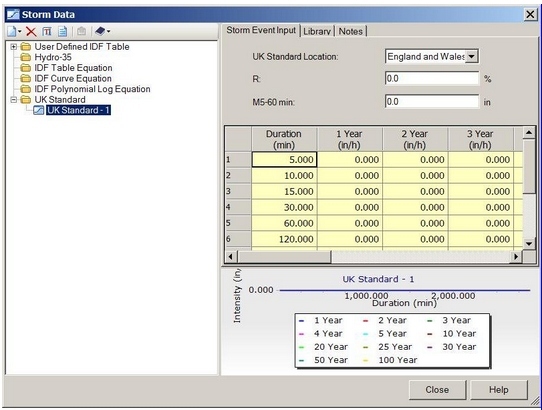
For the time of concentration in a catchment, a UK user can select a Tc Input Type of Composite Tc and on the Tc Data Selection select Wallingford (UK). The hydraulic length and slope fields must be filled in. They can also use a User Defined Tc.

When exporting to MicroDrainage the label of the exported conduit is based on the UK dendritic numbering mechanism of the branch pipe.
Bentley Map Data Source in ModelBuilder
Bentley Map is now available as a data source type in ModelBuilder. You must be running StormCAD within MicroStation with Bentley Map activated in order to see this option in ModelBuilder. You will select to import or export any available data sets that are saved in the currently open Bentley Map file.
Communities search
Information available on Communities about some tools like Modelbuilder, Scenarios, Default Design Constrains can be accessed from the tool itself. Which will open up the topic related information on communities
Please see here for more details about using Communities.

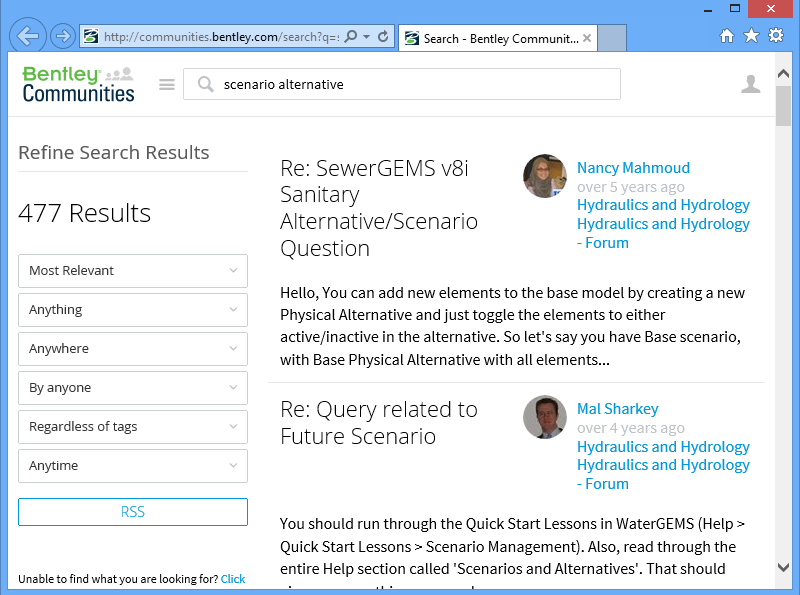
RSS feeds in standalone
Once you have been on the Be Communities website and created an account, you can sign up for RSS Feeds. On the Be Communities website, log in, then scroll down to the bottom and you will see, under Social Media, RSS Feed.

Once you have signed up for the RSS Feed and chosen the subjects for your feed, when in StormCAD, you can go to Help > RSS Feeds to see a list of the wikis and/or forums on your feed. Note: You must have created a new project or have an existing project open in order to do this.

After you select RSS Feed a box will open with your feeds. You can do a search by typing a search term in the search bar, or you can do a filter by clicking on the filter button. If you click on the settings button in the upper right corner, a dialog box will pop up. Here you can select a product's feed.

See Also